Chapter 3, Part 1 - Chord Identification
There’s no substitute for learning a piece of music aurally. No system of written notation can accurately convey the nuances of timbre and dynamics of a composition. Sheet music is the most comprehensive notational system at our disposal. It’s a great way to learn a piece of music but it is not a great memory aid because of its complexity. Jazz musicians adopted a shorthand for chord identification using letters and numbers. This notational shorthand is meant to be a memory aid, not a set of directions. It is meant to be a reminder of something previously learned. “Chords built on Thirds” summarizes the common chord names used in Jazz.
Chords Built on Thirds
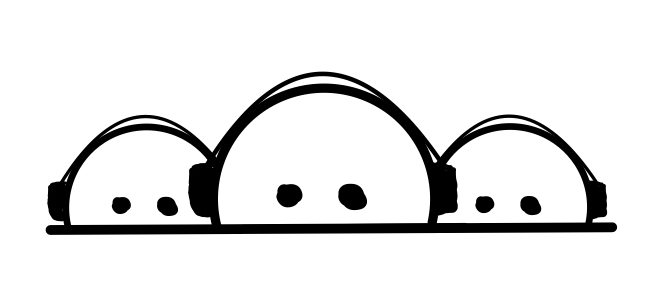
Describing chords as a set of stacked thirds is the basis of Western harmony. Example 1 shows what’s called a “C Major seventh chord”. No matter how we rearrange the notes (inversions) it is still a “C Major seventh chord” because, by convention, the inversion that is all thirds (root position) defines the chord.
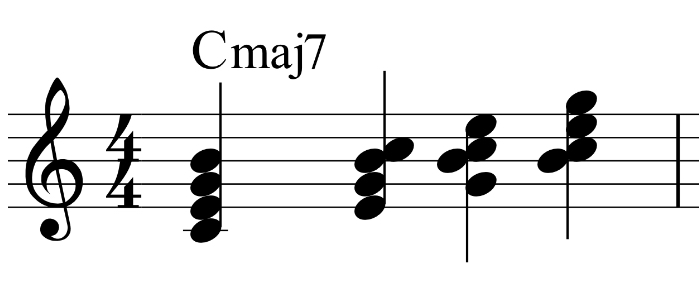
It doesn’t take long before this basic convention runs into problems. Example 2 shows a stack of thirds built up from ‘a’ – this chord is called an “A minor seventh chord”. But as we will soon see the first inversion of this chord could be called a “C sixth chord”.
As we move through “Our Analysis” we will see this “problem” can be put to good use – Am7 and C6 are “sister chords”.

Ultimately, identifying chords correctly comes down to context. Consider the key signature, consider the root movement, consider the tension and release of the chord progression. And, if all else fails flip a coin. Remember this is just shorthand – if you can remember how to get the sound you can call it anything you want!!
So, let’s go. These are the typical chord names you will find on lead sheets:
First, the triad names. Notice that c – eb – g# is not a C chord; it is heard as an enharmonic (g# = ab) inversion of Ab. Ab/C means Ab with a C bass.

There are really only two major 7 chords. You can, of course, add a 7th to any triad but you will find they are inversions of other chords.

Making the 7th degree flat gives us these chords. The fourth example is a half diminished or Cm7 with a b5. The last in the row is diminished, using a 7 double flat (b double flat is an a)

If we keep stacking 3rds onto the 7th chord we find the 9, 11 and 13 chord extensions. Some people refer to this as an “upper structure triad”.
Tip: to quickly find the diatonic upper structure triad, form a minor chord a tone above the chord in question (a D minor triad above our C chord). 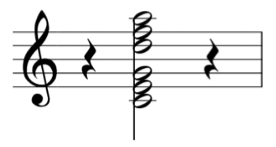
The 9th chord can be diatonic, flat or sharp. If the third of the chord is missing it might be called a suspended 2 chord or sus2.

The 11th can be diatonic or sharpened. If the third of the chord is missing it may be called a suspended 4th (sus4 or just sus). If the fourth is missing it might be called a b5 chord.
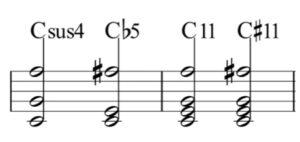
The 13th can be diatonic or flattened. If the seventh is missing it can be called a 6th chord.
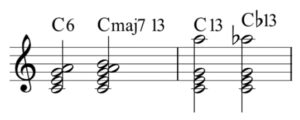
Explore these Upper Structure Extensions in more depth here: Playing With Upper Structure Triads (Link).
Upper Structure Extensions in Context
It might be helpful to look at and listen to how some composers have used diatonic and altered 9ths, 11ths and 13ths in their songs:
Indeterminate Chords
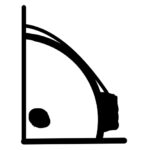
When we start looking through the songs in “Our Analysis” (Link) it doesn’t take long before we start seeing chords that are not obviously one of the chords we talked about above in the section “Chords Built on Thirds”. We call these chords “Indeterminate“. There are a number of reasons a chord might be considered indeterminate:
Incomplete Chords
A chord might be missing a note. The ‘?’ Chord in bar one of Example 3 looks like it could be almost anything but if we look at it’s inversions and pick the one closest to a stack of thirds (*) it looks like it’s probably a Cmaj7 with a missing 5th. The 5th could be flat or sharp but it is less likely.
The ‘?’ chord in bar three is slightly harder to name – it could be a C7 or a Cm7.

Chords with More Than One Name
Chords and their inversions can have different names. “Sister chords” are built right into the tertian system. We define a sister chord as having three common tones with another chord. Example 4 shows how closely the I chord is to the VI chord. The V chord is related to the VII chord and the IV chord is related to the II chord. The III chord stands out because it has two “sisters” – the I chord and the V chord. Add a 13th extension to the I chord and it is the same as the VI chord with an added 9.

‘Symmetrical Chords’ are another type of chord that can have more than one name. The diminished 7 chord is symmetrical (three minor thirds stacked) so each inversion is a different dim7 chord. The augmented triad works the same way.
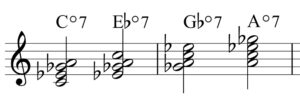
Chords not built on thirds
Chords can be intentionally non-tertian. These chords don’t always even function tonally. Beginning in the early 1960s some Jazz composers and improvisers started using these chords to explore new areas of expression.

We get into “Indeterminate Chords” in more detail on our page ‘Advanced Chord Analysis’ (Link). We look more closely at these chords and offer a procedure for identifying them.
